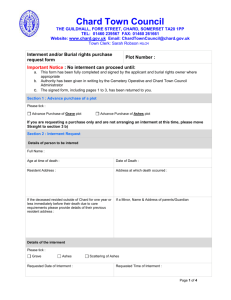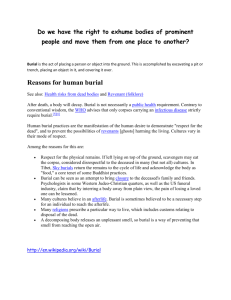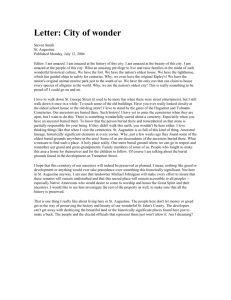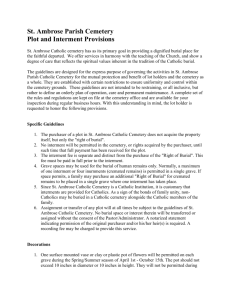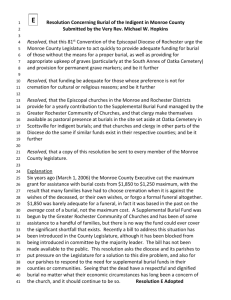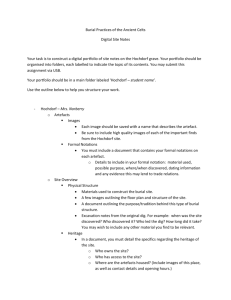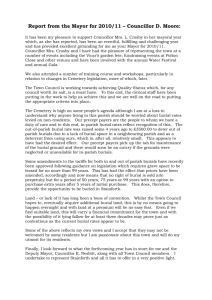Burial & Cremation Act 2013 (SA) - Local Government Association of
advertisement
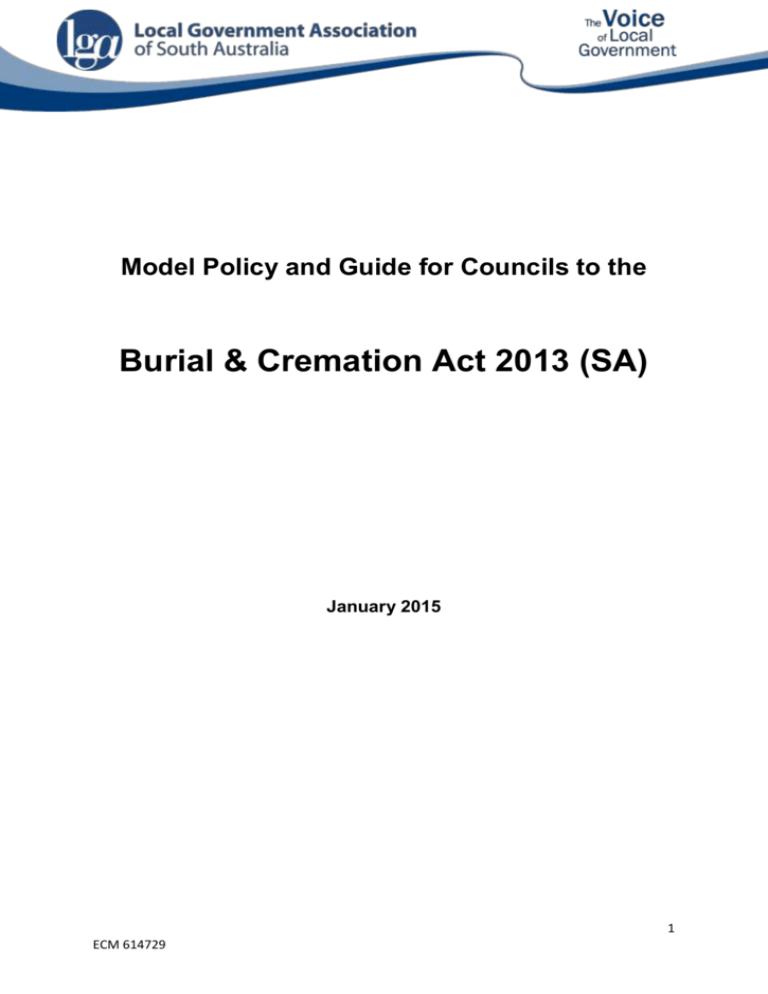
Model Policy and Guide for Councils to the Burial & Cremation Act 2013 (SA) January 2015 1 ECM 614729 Guide for Councils Exercising Powers under the Burial & Cremation Act 2013 – January 2015 1 Introduction There are over 700 recorded cemeteries in South Australia, most under the care and control of Councils, churches or cemetery trusts. This guide is designed to assist Councils to consider and discharge their strategic and operational responsibilities under the Burial and Cremation Act 2013 (the Act) and the Burial & Cremation Regulations 2014 (the Regulations). This guide includes, as an Attachment, a model policy for Councils to modify and adopt as appropriate to their circumstances. The guide and model policy should be read in conjunction with the Management Plan Guidelines for South Australian Cemeteries 1 produced under the auspices of the LGA. Although released in 2005 this document was still pertinent at the time this guide was written. It is aimed at ensuring cemeteries are managed in a way that preserves and enhances their cultural and natural heritage values while, where appropriate allowing them to continue to function as operational burial places. The Act is a comprehensive statutory framework which provides for: the use of natural burial grounds (NBGs) in addition to conventional cemetery interments; the re-use of existing interment sites where the interment right has lapsed; the conversion of closed cemeteries and NBGs into parklands, public parks and gardens; the policies and procedures which need to be adhered to by cemetery authorities in discharging their responsibilities under the Act; and discharge of regulatory powers by Councils for any cemetery or NBG within its area. When the Act commenced in 2014, it repealed the former Cremation Act 2000; and amended parts of the Adelaide Cemeteries Authority Act 2001, the Births, Deaths and Marriages Registration Act 1996, the Local Government Act 1934 and the Transplantation and Anatomy Act 1983. This guide is focussed on providing basic information and practical advice for Councils which own or are responsible for the administration of cemeteries and NBGs within their area. Many Councils own, or have in trust, operating and/or closed cemeteries managed by their administration or controlled by one or more Council Committees.2 As a consequence Council is effectively the “relevant authority” responsible for the discharge of the requirements of the Act at those cemeteries. It is important that Councils review the new legislative requirements to ensure that the statutory powers established by the legislation are being discharged in a timely and appropriate manner by Council’s administration or its Committee. In addition the Council has powers under the Act by which it may step in and take action when any cemetery or NBG (e.g. on church, trust or privately-owned land) is “neglected” or “fails to comply” with the Act. 1 McDougall & Vines Management Plan Guidelines for South Australian Cemeteries 2005 (1.2 Mb, PDF) i.e. a Committee constituted under section 41 of the Local Government Act 1999, often referred to as a ‘Section 41 Committee’. 2 2 ECM 614729 Guide for Councils Exercising Powers under the Burial & Cremation Act 2013 – January 2015 The legislation contains significant penalties for breaches of the Act by individuals and corporate bodies. Words and phrases used in this Guide have the same meaning as they do in the Burial and Cremation Act 2013 and/or the Burial & Cremation Regulations 2014. 2 How is demand for interment sites expected to change? There are a range of policy and operational options which Councils need to consider to meet future demand for interment of human remains. The Australian Bureau of Statistics3 “Burial and Cremation Trends in SA” has summarised a 20 year trend (1990-2010) that indicates cremations increasing by 29% and burials decreasing by 15% during that period. The article concluded that by 2010 burials accounted for only around 34% of all interments. The Bureau projected the number of deaths in South Australia to double by 2056 which, on current indications, means that, despite the declining popularity of burials, about 7,000 burials will still be undertaken annually. This will require at least 2 hectares of land per annum for interments by burial. Many existing cemetery facilities are approaching capacity. Land in close proximity to towns and cities is restricted in terms of availability and suitability. As a consequence of these trends, and the commencement of the Act, Councils should consider the likely future demand for burial sites, as well as their existing policies and management operations of any Council cemetery. This consideration might include the possibility of: reusing existing interment sites by reassignment; diversion to cremation or alternative disposal methods; and extending present facilities, by acquisition of new sites, and/or exchange of land. To discharge this responsibility Councils need to: identify existing interment sites and their unused capacity; forecast future interment requirements for their area; identify opportunities for new cemetery sites; consider land acquisitions and exchanges; determine length of tenure of Interment Rights in Council facilities; consider Natural Burial Grounds as an alternative to cemetery sites; review their Cemetery Management Plans; review Community Land Management Plans for land dedicated for cemeteries or natural burial grounds; and establish succession plans for cemeteries and NBGs i.e. conversion to public parks/gardens on closure; to ensure that their facilities can cater for expected interments. Meeting this challenge on a regional basis represents an opportunity for co-operation between Councils. 3 ABS 1345.4 March 2010 http://www.abs.gov.au/ausstats/abs@.nsf/mediareleasesbytitle/DE101C82C9E8C378CA25770E0020 4AFF?OpenDocument 3 ECM 614729 Guide for Councils Exercising Powers under the Burial & Cremation Act 2013 – January 2015 3 Understanding the Legislation Although this guide contains quotations from the Act, bear in mind that the Act might have been amended since this guide was written. Refer to the current version of the Act and/or the Regulations for specific, up-to-date and full content. The Act and the Regulations define the powers and responsibilities of Councils to ensure facilities within their area are properly maintained. The legislation requires specific delegations to Council’s authorised officers to exercise control and care for cemeteries, NBGs and crematoria. Councils need to ensure they have appropriate operating procedures in place to manage their own interment facilities and ensure they discharge their responsibilities as a regulator of any non-Council cemeteries within their area. 3.1 Interment Rights Previous legislation restricted interment rights to a maximum of 99 years. These rights were able to be renewed under certain conditions. However, the former legislation prevented cemetery authorities from issuing interment rights “in perpetuity”. The Burial and Cremation Act 2013 allows for the duration of interment rights to be for a specific period or in perpetuity at the discretion of the cemetery authority.4 This may have an impact on the remaining available sites in older cemeteries. Importantly the Act and the Regulations allow establishment of “natural burial grounds” (NBGs) as alternatives to cemeteries, or as part of a cemetery. The Act regulates both cemeteries and NBGs. It specifies how both are to be managed, eventually closed and how either a cemetery or an NBG might eventually be converted to a public park or garden, if and when it is no longer used for burials. 3.2 Disposal of Human Remains Sections 7 to 11 of the Act and Regulation 4 of the Regulations set out the requirements for disposal of bodily remains. In townships and in metropolitan Adelaide, burials may occur only in a cemetery or an NBG, regulated under the Act. Cremation is permitted only after the Registrar of Births Deaths and Marriages has issued a cremation permit. However, once a body has been cremated, there are no restrictions in the Act about what relatives may do with the cremated remains. In brief, sections 7 to 11 make it an offence to dispose of human remains in any way other than: burial in a cemetery or natural burial ground; burial in a mausoleum or vault; cremation (only after receipt of a cremation permit); or burial on any land in “an area outside a township or Metropolitan Adelaide” subject to four conditions, i.e. that: o permission is obtained from the land owner; o permission is obtained from the Council (if the land is in a Council area); 4 Section 31 of of the Act. 4 ECM 614729 Guide for Councils Exercising Powers under the Burial & Cremation Act 2013 – January 2015 o o the grave is at least one metre deep; and the grave is at least 20 metres away from any building, structure or water well. Accordingly, Councils outside metropolitan Adelaide should expect to receive occasional applications under Section 8 of the Act, for permission to bury a body on rural land. The Model Policy included with this Guide includes, as Attachment 4, a model form that can be used by a Council, to grant permission for a burial on private land. There is no requirement in the Act for Councils to maintain a register of such burial sites. However, Council’s policy may require full details of the interment site prior to granting approval. The requirements of the Act apply to burial on rural land and the applicant would need to ensure that those requirements were fully met. 3.3 Documents to be provided before Disposal of Bodily Remains Section 12 of the Act and Regulations 7 and 9 outline the documentation that must be provided before disposal of bodily remains may be undertaken. This is very important. There is a maximum penalty of $10,000 or imprisonment for two years, for allowing or permitting disposal of human remains without seeing (and recording the details of): a certificate of identification for the body; and a partial certificate of cause of death; or a disposal authorisation; or an authorisation to dispose of human remains granted by the Minister or the Registrar under section 12. In addition Regulation 17 requires an identification plate to be attached to a coffin, (or receptacle in the case of cremations) or placed on top of the remains if interred without a coffin. 3.4 Opening of Interment Sites Section 13 of the Act deals with the opening of interment sites, exhumation and re-interment. There are restrictions and/or regulated procedures that must be observed before: opening a burial plot for the purpose of interring additional human remains, (e.g. a ‘lift and deepen’ process); removing remains; and/or transferring remains from one location to another. Penalties for breaching Section 13 are severe: a fine of up to $20,000 or imprisonment for up to four years. 3.5 Responsibilities of Cemetery Authorities Sections 16, 17 and 18 of the Act outline the responsibilities of a cemetery authority in ensuring that: human remains interred in a cemetery or NBG are the remains of the deceased person entitled to be interred in that site;5 religious and cultural customs and practices are not interfered with; and 5 This could pose a dilemma for a Council if, for example, part of a cemetery or burial ground is reserved for followers of a particular religion, and the Council cannot be assured that the deceased was recognised as an adherent of that religion. 5 ECM 614729 Guide for Councils Exercising Powers under the Burial & Cremation Act 2013 – January 2015 3.6 unclaimed cremated human remains are disposed of in a manner consistent with the legislation. Creation of Cemeteries, Natural Burial Grounds and Crematoria Sections 19 to 23 of the Act outline the powers for the establishment of cemeteries, NBGs and crematoria including the designation of NBGs within cemeteries. 3.7 Closure and Dedication of closed Council Cemeteries as park lands Sections 24 to 28 of the Act provide the basis on which cemeteries and NBGs (or part of the area) may be closed, when they are no longer used for burials. Sections 25 and 26 envisage that closed cemeteries or NBGs (or parts thereof) may become parks or gardens, subject to following certain processes and procedures, including specific provisions for public consultation, and how in the event of closure, the Council as the “relevant authority” must deal with its record of interments, and any person who might have held future burial rights in the former cemetery or NBG. 3.8 Issue and management of Interment Rights Sections 29 to 38 of the Act outline the rules governing interment rights at cemeteries and NBGs. These sections affect a Council’s responsibilities, and the rights that may be exercised by relatives of the deceased. They cover the rules relating to the duration, renewal, transfer and surrender of rights; the keeping of records of these rights, and the possible re-use of burial sites. These sections serve a purpose similar to consumer protection, insofar as they guarantee certain standards, and impose limits on how a Cemetery authority can manage interment rights. Those charged with managing a Council cemetery or NBG should study and become familiar with these provisions. 3.9 Memorials Sections 39 to 42 of the Act deal with the ownership of, and responsibility for, memorials in cemeteries, NBGs and other places of interment. The ownership of a memorial and the responsibility for its maintenance rests with the holder of the interment right. However, a Council as a “relevant authority” for a cemetery or NBG can offer to take over responsibility for maintaining a memorial, for a fee. Only if a memorial becomes unsafe can a Council (as the relevant authority for the cemetery or NBG) insist that the memorial be repaired, removed or re-instated. If no action is taken then the Council may use its power under section 41 of the Act to have the necessary work done and recover its costs from the owner of the memorial. When interment rights have expired for more than two years and a memorial is unclaimed, despite written notices to the owner, then there are powers in section 42 to eventually dispose of the memorial, while keeping an appropriate record. 3.10 General Powers of Relevant Authority Under sections 43 to 45 of the Act, the Council as the “relevant authority” for a cemetery, NBG, or crematorium, is able to enlarge, improve; restrict interment (where no right exists) and take any action for the proper management and maintenance of the facility. In so doing, it must have regard to the customs and needs of various ethnic and religious communities “to the extent that is reasonably practicable”. 6 ECM 614729 Guide for Councils Exercising Powers under the Burial & Cremation Act 2013 – January 2015 3.11 Powers of Councils in respect of Neglected Cemeteries or Natural Burial Grounds Under section 46 of the Act, a Council has the power to intervene in the operation of cemeteries or NBGs that it does not itself own or operate. These powers may be used when the Council forms the opinion that any cemetery or NBG is “in a neglected condition” or that its administration has been failing to “comply with the requirements” of the Act. In these circumstances, the Council may step in, and issue a notice to the person or body “responsible for the administration of” the cemetery or NBG, requiring specified work to be carried out. At least 28 days must be allowed for a response, after which the Council may do the specified work and charge those responsible for the cost. Anyone receiving a Council notice in these circumstances can ask the District Court for a review. The Council can appoint one or more “authorised officers” to assist the Council in exercising these powers. See section 3.15 below. 3.12 Power of Councils to accept trusts Sections 48 and 49 of the Act deal with the ability of Councils to accept handover of a cemetery or NBG at the request of the relevant landowner, or trustee of the land. The same power exists if the former administrators of the land no longer exist, or cannot be ascertained. However, the Council cannot accept control of a cemetery or a NBG if under the terms of any applicable trust, the cemetery or NBG can be used only by or for a particular religion. 3.13 Public access Under section 50 of the Act, there must be free public access to cemeteries, NBGs and crematoria. Access must be allowed “at any reasonable time” for “any legitimate noncommercial purpose”. However, if a Council suspects that an offence is about to be or has been committed, a visitor may be required to leave. 3.14 Registers, records and plans Under section 53 of the Act, the Council as the “relevant authority” must maintain, and make available to the public, documentation that: (i) (ii) (iii) (iv) identifies persons whose remains are interred, the site in which the remains of each such person are interred; and records exhumations of human remains interred records interment rights issued and memorials erected identifies each site at which human remains are interred and each site set aside for the interment of human remains; records of cremations carried out (where applicable) Detailed requirements for these records are set out in Regulation 36 of the Regulations. The registers must be available for inspection by the public during office hours. A fee may be charged for inspection. 7 ECM 614729 Guide for Councils Exercising Powers under the Burial & Cremation Act 2013 – January 2015 3.15 Authorised Officers of Council Sections 58 to 60 of the Act allow a Council to appoint one or more “authorised officers”, subject to any conditions limiting that person’s powers (e.g. for a limited time, or to only one cemetery or NBG.) Authorised officers must be issued with identity cards. The powers of authorised officers, outlined in Section 59, are intended to assist the administration of the Act and allow potential offences to be investigated. These powers extend to entering and inspecting any cemetery, NBG, crematorium, mortuary; and even any relevant vehicle (e.g. a hearse) taking photos or video seizing and retaining anything reasonably suspected of being used in or constituting evidence of an offence against the Act; requiring suspects to produce identification and answer questions; going to a Magistrate to seek a warrant for further powers e.g. to compel production of documents, to use force to enter premises It is an offence to hinder an authorised officer, to fail to comply with his/her directions, or to make false or misleading statements. 3.16 Offences by a Body Corporate Section 64 of the Act imposes liability not just on bodies corporate (companies, and Associations) but also on each member of the governing body of the body corporate (e.g. the Committee members of any Association) unless each person used “due diligence” to try to prevent the offence. When the alleged offence is a cremation without permission, the burden of proof to establish “due diligence” is on the individual. 4 Conclusion In summary, the requirements of the Act place responsibilities on Councils to ensure that the cemeteries and other interment sites under direct or indirect Council control are properly managed and maintained and that appropriate records are kept. If a Council has established a Committee to administer a cemetery or NBG, then the Council should review the terms of reference for such a Committee to ensure that its terms of reference are consistent with the Act. It would also be prudent to adopt a Council policy, outlining the Council’s objectives and principles in discharging its obligations under the Act. A model policy is provided below. Production of this document was made possible by the Local Government Research and Development Scheme. 8 ECM 614729 Cemeteries and Natural Burial Grounds –Model Policy – January 2015 Cemeteries and ‘Natural Burial Grounds’ Model Policy Strategic Reference File reference Responsibility Revision Number Original Effective date Last revised date Every 2 years (or sooner, in the event of legislative change) Minutes reference Next review date Applicable Legislation Burial and Cremation Act 2013 (“the Act”) Burial & Cremation Regulations 2014 (“the Regulations”) Development Act 1993 Heritage Places Act 1993 Interment Right (Attachment 1) Transfer of Interment Right (Attachment 2) Burial Application (Attachment 3) Burial Application for permission to inter bodily remains on land other than a cemetery or natural burial ground (Attachment 4) LGA “Guide for Councils to the Burial & Cremation Act 2013” Related Policies Related Documents: 1. Purpose This policy outlines XXXX Council’s objectives in respect of Council owned and operated cemeteries, natural burial grounds and crematoria. It has regard to the Burial and Cremation Act 2013 (the Act) and the Burial & Cremation Regulations 2014 under which Council cemetery authorities must meet revised requirements for the operation and regulation of cemeteries, natural burial grounds and crematoria within the Council area. Council recognises that these community cemeteries are the resting place of many of the district’s pioneer and respected citizens and will efficiently and effectively manage them in a caring and equitable manner to meet the needs of its community. 2. Definitions Words and phrases used in this policy have the same meaning as they do in the Burial and Cremation Act 2013 and/or the Burial & Cremation Regulations 2014. 9 ECM 614729 Cemeteries and Natural Burial Grounds –Model Policy – January 2015 3. Principles The policy applies to cemetery and natural burial facilities located, owned or operated by Council in [the townships/settlements of]: XXXX YYYY ZZZ etc. Each [township/settlement] cemetery and natural burial ground is overseen by a Committee of Council constituted under section 41 of the Local Government Act 1999. [or insert alternative arrangements for cemetery management] The management of burials and granting of interment rights in Council facilities is vested in the Council and delegated to its administration. Existing reservations issued by Council prior to the development of this policy will be honoured by Council and renewal of interment rights will have regard to the basis on which the original burial sites have been allocated. The cemeteries and natural burial grounds [will] will not be segregated into areas based on religion or ethnicity in accordance with section 22 of the Act. Council will have regard to the customs and specific needs of all those who apply for an interment permit. In considering applications and/or renewal of interment rights Council will have regard to: 4. the Cemetery’s local historical significance as a burial place for many of the pioneers of the area the need for each cemetery site to be managed and maintained at a standard consistent with its significance and as an important family memorial place remaining interment sites available, recognising relatives of people already interred in the cemetery, people with a long association to the area, and those who have made contributions to the well-being and social fabric of the community Issue of interment rights Interment rights may be granted by Council for one or more sites within a cemetery or natural burial ground on completion of an application and payment of the appropriate fee. The interment right gives the holder the exclusive right to bury or inter human remains in the allotted site. The holder of the interment right (Attachment 1) may use the site only for interment of human remains consistent with this Policy and the Burial and Cremation Act 2013 . Council [will/will not] grant interment rights in perpetuity. Interment rights may be issued for the following: 4.1 Grave sites (for new interments) for a dual depth system of burial. The site can be used to accommodate family members and the term of the interment right is XX years with renewal rights for a second period on the 10 ECM 614729 Cemeteries and Natural Burial Grounds –Model Policy – January 2015 application of an interment right holder or authorised person. (See section 30 of the Act.) 4.2 Mausoleum Council may approve an application for construction of an above ground structure subject to Council specifications. 4.3 Memorial or niche walls The term of an interment right for ashes, in a memorial or niche wall is for a period of XX years with a second period available on the application of an interment right holder or authorised person. (See section 30 of the Act.) 4.4 Vaults Council may on application approve the construction of a water tight vault (distinct from a mausoleum) of either single or dual capacity depth. Approval will be subject to soil and ground water conditions, design and specifications. Construction will be in accordance with the specifications provided and subject to supervision of Council’s building supervisor or a contractor approved by Council. (See section 30 of the Act.) 4.5 Scattering of ashes No interment right is required for scattering of cremated remains in a cemetery or natural burial ground. However, prior approval of the Council is required. (See section 36 of the Act.) 5. Renewal or transfer of Interment rights 5.1 Renewal At the end of the interment right period Council may, on application of the interment right holder or an authorised person, renew or extend an interment right on payment of an appropriate fee. (See section 32 of the Act.) 5.2 Transfer or surrender of interment rights A person/family holding an interment right for an unused burial site or memorial wall may seek approval of Council to surrender (section 34 of the Act) or transfer (section 33 of the Act.) the right to another person/family. (See Attachment 2) Council will not unreasonably withhold its approval. However, administrative costs for the surrender, formal transfer and recording in Council’s register will be at the cost of the holder of the interment right in accordance with Schedule 1 of the Regulations. 5.3 Lost documentation Council may issue a replacement (copy) of an interment right upon receipt of a Statutory Declaration by the interment right holder or an authorised person which sets out the circumstances in which the formal documentation was lost. 6. Reuse of Interment sites In the event that a right of interment is not renewed Council will take reasonable steps, in writing, to advise a holder of the right of the impending expiration of the right twelve months prior to its expiration. If the holder of the right does not renew the interment right by the expiration date: for a burial site: the interment site is deemed to have expired and Council has the right to reuse the site in accordance with the legislation for an ashes interment site: the holder of the interment right may: 11 ECM 614729 Cemeteries and Natural Burial Grounds –Model Policy – January 2015 a. instruct the Council to move the interment remains to an unmarked location in the cemetery, or b. collect the remains for private disposal and Council has the right to reuse the site in accordance with the legislation 7. Disposal of Human Remains 7.1 On rural land In accordance with sub-section 8(2) of the Act, the Council will receive applications and may grant permission for a burial on private land outside “metropolitan Adelaide” and outside the boundary of a township. The request must be made on the application form (Attachment 4) appended to this policy. [This paragraph applies only to a Council with some area outside a township and outside metropolitan Adelaide.] 7.2 Documentation All applications for a right to inter bodily remains in a Council cemetery or natural burial ground must be accompanied by appropriate documentation in accordance with section 12 of the Act and Regulation 9 of the Regulations. Council cannot allow disposal of human remains without seeing (and recording the details of): a certificate of identification for the body; and a partial certificate of cause of death; or a disposal authorisation; or an authorisation to dispose of human remains granted by the Minister or the Registrar under section 12 of the Act. All interments in Council owned/operated cemeteries or natural burial grounds are to be approved by Council on the application form appended to this Policy. (See Attachment 3) Interments are to be undertaken by the funeral company specified on the Burial Authority. Preparation of the interment site is to be undertaken by Council or a contractor authorised by the Council. 7.3 Register/Records & Plans Under section 53 of the Act, the Council as the “relevant authority” must maintain, and make available to the public, documentation for each cemetery or natural burial ground. Copies of the registers and plans of the cemetery are available for inspection by members of the public during Council office hours. 7.4 Access to an interment site A holder of an interment right (including those who have existing Interment Rights) is required to comply with the Act and the approval given by Council, prior to: interment of human remains in a cemetery or natural burial ground reopening an interment site containing bodily remains removing or relocating human remains. The process of excavating and/or modification of a site must be undertaken by a Council employee or a contractor approved by the Council. Confirmation of a burial site must be verified by Council’s Administration prior to any excavation or other work on the site 12 ECM 614729 Cemeteries and Natural Burial Grounds –Model Policy – January 2015 8. Memorials 8.1 Headstones or Plaques Headstones or plaques which do not exceed the dimensions below do not require specific Council approval. Headstone for Standard (single) site: Xcm x Ycm Headstone for double site: Xcm x Ycm Memorial Walls: Xcm x Ycm per site If a larger plaque or headstone size is required, application may be made to Council for approval. Council may issue approval, subject to specific conditions. 8.2 Installation of headstones or plaques Only Council staff or a contractor approved by Council shall install a headstone or plaque. 8.3 Ornaments Breakable ornaments or tributes placed on a plinth adjacent to a site shall not exceed XXcm in height. Ornaments, vases, aged flowers and wreaths may be removed from sites, if Council forms the opinion that the items have deteriorated to the extent that they are unsightly. 8.4 Lighting Solar powered lights or spikes on individual sites are prohibited. 8.5 Ownership and maintenance of memorials The ownership of plaques, monuments and other approved structures remains with the Interment right holder. The Council is not responsible for the upkeep, repair or maintenance of any memorial [unless the internment right holder has separately contracted with the Council for this purpose]. In accordance with section 41 of the Act, the Council may issue a notice on the owner of a memorial requiring repairs, removal or reinstatement of the memorial. Council may act to remove any structure that it deems to be unsightly, in poor condition or dilapidated or repair it consistent with section 41 of the Act at the owner’s cost. 8.6 Power to dispose of unclaimed memorials Council may, after giving notice in accordance with section 42 of the Act, remove and dispose of the memorial. 8.7 Monuments and memorials in natural burial grounds In natural burial grounds, permanent memorials will not be installed on individual interment sites. However Council will allocate a small area of the natural burial ground for installation of approved memorabilia. 9. Service fees and charges Council will annually determine a “Schedule of fees and Charges” for services provided at cemeteries and natural burial grounds as part of its budget process. 13 ECM 614729 Cemeteries and Natural Burial Grounds –Model Policy – January 2015 10. Neglected cemeteries and natural burial grounds If Council is of the opinion that a cemetery or natural burial ground within its area is in a neglected condition or fails to comply with the requirements of the Act the Council may, by notice in writing, require the governing body to remedy the conditions of neglect or non-compliance. If those remedial works are not undertaken in accordance with the Act the Council may undertake the work and recover the costs from the governing body or Interment right holder. (See section 46 of the Act.) The Authority on which the notice is issued can apply to the District Court for a review of the decision. 11. Authorised Officers Council may appoint authorised officers to ensure administration and enforcement of section 59 of the Act. 12. Further information This policy will be formally reviewed every two years, or following amendment to the legislation. Minor variations can be approved by Council at any time following consideration of a recommendation and report from the Chief Executive Officer. This policy and the Register of Cemeteries and Natural Burial Grounds will be available for inspection at the Council offices listed below during ordinary business hours. The policy is available to be downloaded, free of charge, from Council’s internet site: www.xxxxx.sa.gov.au Any grievances in relation to this policy or its application should be forwarded in writing addressed to the Chief Executive Officer of Council. 14 ECM 614729 Cemeteries and Natural Burial Grounds –Model Policy – January 2015 Interment Right Attachment 1 XX Council hereby grants interment rights to ______________________________________________________ (the “Interment Right Holder”) of _______________________________________________________________________________ for the exclusive right of interment of human remains / interment of cremated human remains / memorialisation without human remains at __________ Cemetery in the site designated below for a term of ___________ years. The Interment Right Holder may extend this interment right for further terms. The interment right is granted in accordance with the Burial and Cremation Act 2013 and is subject to the rules of the Authority which are in force during the term of this interment right. The interment right can be extended for a further period not exceeding the initial term for payment of an approved fee. The Interment Right Holder or an authorised person can apply to have the Interment Right transferred to another party. As from ____________________________________ Expiring on _______________________________ Type of interment right ________________________________________________________________ Site location ______________________________________________________________________________ Interments at site Names Interment Type ________________________________________ Signed (CEO) Interment Date Interment Level ______________________________ Date 15 ECM 614729 Cemeteries and Natural Burial Grounds –Model Policy – January 2015 Transfer of Interment Right Attachment 2 Application for transfer of interment right Type of interment right: ______________________________________________________________ Site location: _______________________________________________________________________ Currently in the name(s) of: ___________________________________________________________ Please select and complete all details for either A (current interment right holder/s) or B (authorised Person) below and sign in front of a JP on page 2. A. I, the current registered interment right holder, do solemnly and sincerely declare that: I, (full name) ____________________________________ (date of birth) ______________ of (address) ________________________________________________________________ (telephone) __________________________ (mobile) ____________________________ (email)__________________________________________________________________ (And) I, (full name) ____________________________________ (date of birth) ______________ of (address) ________________________________________________________________ (telephone) __________________________ (mobile) ____________________________ (email)__________________________________________________________________ do hereby authorise the transfer of my rights, title and interest in this interment right. OR B. I, the authorised person, do solemnly and sincerely declare that: I, (full name) ____________________________________ (date of birth) ______________ of (address) ________________________________________________________________ (telephone) __________________________ (mobile) ____________________________ (email)__________________________________________________________________ Being a person having the right to exercise a Power of Attorney for the interment right holder. (Please attach a copy of the Power of Attorney) : OR Being a person entitled to exercise the rights granted to the interment right holder upon the interment right holder’s death, and being the highest ranking person of entitlement in relation to the deceased interment right holder, and having provided 16 ECM 614729 Cemeteries and Natural Burial Grounds –Model Policy – January 2015 proof of my identity (Council has the right to determine the criteria to determine the relationship and entitlement of any person claiming a substituted right) do hereby request the interment right to be transferred to the new interment right holder as detailed below. I, the CURRENT INTERMENT RIGHT HOLDER/S or AUTHORISED PERSON, understand that the said interment right (Interment Right Number: __) is unencumbered and I make this solemn declaration conscientiously believing the same to be true and by virtue of the provisions of the Oaths Act 1936. Signed: _________________________________________________ (interment right holder of authorised person Signed: _________________________________________________ (Interment right holder 2 This section must be signed in front of a Justice of the Peace or Commissioner of Affidavits. Declare and subscribed at_____________________________________________________________ this___________________________________ day of ____________________ Year ______________ Before me (Full Name) _______________________________________________________________ A Justice of the Peace or (Signed JP/Commissioner) Commissioner for Affidavits ______________________________________ NEW INTERMENT RIGHT HOLDER (1 ONLY – PLEASE INSERT FULL DETAILS) Title: Dr Mr Ms Mrs Miss Full Name: _________________________________________________________________________ of: _______________________________________________________________________________ Suburb: __________________________________ State: __________________ Postcode: _________ Date of Birth:_______________________________________________________________________ Tel (W) ___________________________________ Tel (H) ___________________________________ Mobile ____________________________________________________________________________ Email: ____________________________________________________________________________ hereby accept the transfer of the above interment right to my name. NEW INTERMENT RIGHT HOLDER TO SIGN – not in front of JP I _________________________________________________________ (Full name of new interment right holder) Signed: ______________________________________________________ Date: _______________ 17 ECM 614729 Cemeteries and Natural Burial Grounds –Model Policy – January 2015 Burial Application Attachment 3 Burial Authority This form must be completed by the interment right holder or a person authorised to exercise the interment right in accordance with Section 35 of the Burial and Cremation Act 2013 (see overleaf). DECEASED DETAILS Title: Dr Mr Ms Mrs Miss Gender: M F First Name/s: __________________________________ Last Name: ____________________________________ Date of Birth: _______________________ Date of Death: ________________________ Age: _______________ Last Known Address: __________________________________________________________________________ Suburb: ______________________________________ State: ____________________ Postcode: ___________ The deceased person died of natural causes Yes No Authorisation for the Certificate of Identification was issued by:______________________________________ INTERMENT LOCATION – please select ONE ONLY A Council to allocate new interment right B Existing location at _________________Cemetery Name of right holders/s ____________________________________ Right Number: _______________ Location Details: ____________________________________________ Expiry Date: _______________ Current Address: ______________________________________________________________________ Suburb: _________________________________ State:__________________ Postcode: ____________ Date of Birth: _________________________________________________________________________ Existing interments at Site: Yes No Extension of right required: Yes No Number of years to be extended ____________ INSTRUCTION FOR INTERMENT – please enter details and indicate as applicable Interment Depth 1 2 Lift and Deepen Required Yes No Coffin Size (in millimetres) _____________________________________________________________________ Length x Width Coffin Type Coffin Casket Number of Previous Interments and Depths: ______________________________________________________ Name of Funeral Company: ____________________________________________________________________ Arranger Name (please print) ___________________________ Arranger Signature: _______________________ AUTHORISED PERSON DETAILS Title: Dr Mr Ms Mrs Miss Gender: M F Date of Birth: ______ First Name/s: __________________________________ Last Name: ____________________________________ Address: ____________________________________________________________________________________ Suburb: ______________________________________ State: ____________________ Postcode: ___________ Tel (W) _______________________________________ Tel (H) ___________________ Mobile _____________ Relationship to Deceased: _______________________ Email: ________________________________________ 18 ECM 614729 Cemeteries and Natural Burial Grounds –Model Policy – January 2015 I acknowledge that I have read and understand my rights and responsibilities and declare that I am the interment right holder or a person authorised to exercise the interment right in accordance with the conditions listed below. Authorised Person’s Signature: _______________________________________ Date: ____________________ __________________________________________________________________________________ __________________________________________________________________________________ __________________________________________________________________________________ NB Copies of documentation which meet the requirements of section 12.2 of the Burial and Cremation Act 2013 and Regulation 9 must be provided. Attached Yes No Your rights and responsibilities: New interment right If a new interment right is being requested in order to facilitate this burial, the Authorised Person will become the interment right holder. In signing this Burial Authority, the Authorised Person acknowledges receipt of a Statement by the Funeral Director if a new interment is required. An interment rights will only be granted to one interment right holder. Authority to exercise the interment right Only the interment right holder may exercise an interment right, provided that if the interment right holder is deceased the interment right may be exercised by the person representative of the deceased interment right holder (by definition the Executor or Administrator of the Deceased Estate) in accordance with section 35 of the Burial and Cremation Act 2013. If there is no personal representative the interment right may be exercised in accordance with regulation 32 of the Burial and Cremation Regulations 2014 as follows: o by the spouse of domestic partner of the deceased interment right holder; or o if there is no surviving spouse or domestic partner – by the eldest living relative of the deceased interment right holder in the following descending order of priority: a child; a grandchild or great-grandchild; a brother or sister; a parent; a grandparent; an aunt or uncle; a nephew or niece; a cousin; any other blood relative 19 ECM 614729 Cemeteries and Natural Burial Grounds –Model Policy – January 2015 Burial Application Attachment 4 Request for permission to inter bodily remains on land other than a cemetery or natural burial ground. Application can only be made for sites outside township boundaries. DECEASED DETAILS Title: Dr Mr Ms Mrs Miss Gender: M F First Name/s: __________________________________ Last Name: ____________________________________ Date of Birth: _______________________ Date of Death: ________________________ Age: _______________ Last Known Address: __________________________________________________________________________ Suburb: ______________________________________ State: ____________________ Postcode: ___________ The deceased person died of natural causes Yes No Authorisation for the Certificate of Identification was issued by:______________________________________ INTERMENT LOCATION AND DETAILS Address of property: ___________________________________________________________________ Suburb/Township: ________________________ State: _________________ Postcode: ____________ General description of the area to be used:________________________________________________ ___________________________________________________________________________________ Coordinates of the location:____________________________________________________________ Intended interment depth:_____________________________________________________________ (Interment must be of at least 1 metre) at a depth Please attach a map showing the intended location of the grave or natural burial site. Identify any features and estimate the distance to surrounding structures. NB The site must be at least 20 metres away from any building, structure or water well. Attached Yes No LAND OWNER DETAILS Title: Dr Mr Ms Mrs Miss First Name/s: __________________________________ Last Name: ____________________________________ Address: ____________________________________________________________________________________ Suburb: ______________________________________ State: ____________________ Postcode: ___________ Tel (W) _______________________________________ Tel (H) ___________________ Mobile _____________ Relationship to Deceased (if any): _________________ Email: ________________________________________ NB Proof of permission of the land owner must be provided. Attached Yes No FUNERAL DIRECTOR DETAILS Name of Funeral Company: ____________________________________________________________________ Arranger Name (please print) ___________________________ Arranger Signature: _______________________ 20 ECM 614729 Cemeteries and Natural Burial Grounds –Model Policy – January 2015 AUTHORISED PERSON DETAILS Title: Dr Mr Ms Mrs Miss Gender: M F Date of Birth: ______ First Name/s: __________________________________ Last Name: ____________________________________ Address: ____________________________________________________________________________________ Suburb: ______________________________________ State: ____________________ Postcode: ___________ Tel (W) _______________________________________ Tel (H) ___________________ Mobile _____________ Relationship to Deceased: _______________________ Email: ________________________________________ I acknowledge that I am a person authorised to exercise the interment in accordance with the conditions listed below. Authorised Person’s Signature: _______________________________________ Date: ____________________ __________________________________________________________________________________ __________________________________________________________________________________ __________________________________________________________________________________ NB Copies of documentation which meet the requirements of section 12.2 of the Burial and Cremation Act 2013 and Regulation 9 must be provided. Attached Yes No 21 ECM 614729
